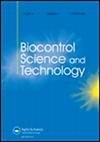Suppression of Meloidogyne incognita by co-application of chitin and Streptomyces nigrescens (AMV1033)
IF 1.2
4区 农林科学
Q4 BIOTECHNOLOGY & APPLIED MICROBIOLOGY
引用次数: 2
Abstract
ABSTRACT Root-knot nematodes, Meloidogyne spp., are among the most polyphagous and ubiquitous plant-parasitic nematodes. Among other management strategies, organic soil amendments and biological control agents are proposed. In this study, potential synergistic benefits of co-application of chitin and Streptomyces nigrescens (AMV1033) against M. incognita were determined. Hypothetically, chitinolytic activity of these microbes deteriorates nematode eggshells reducing nematode numbers. Additional chitin could enhance actinobacteria activity for nematode suppression. In in vitro and greenhouse bioassays, suppressive capacities of M. incognita by chitin amendment at 50 mg/g of soil (chitin-low) and at 500 mg/g of soil (chitin-high; only tested in the greenhouse), Streptomyces nigrescens (AMV1033) and the co-application of AMV1033 with the two chitin rates were tested. After four weeks of in vitro egg incubation, the number of extractable second-stage juveniles (J2s) was significantly reduced after co-application of chitin-low plus AMV1033, and less so after sole application of AMV1033. In a similar 2-week in vitro assay with M. incognita egg masses, the numbers of J2s were similarly reduced after the same treatments. In a watermelon greenhouse bioassay with M. incognita, root infection was decreased after co-application of AMV1033 plus chitin-high or chitin-low compared to the non-treated control. After these treatments, plants grew similarly as in the control, whereas sole chitin-high addition led to severe plant damage. Some amelioration of phytotoxicity of chitin-high by the co-application of AMV1033 was found. The results of the study demonstrated the potential to enhance suppression of M. incognita by S. nigrescens by co-application of chitin.几丁质与黑链霉菌(AMV1033)联合应用对嗜嗜嗜母细胞的抑制作用
根结线虫(Meloidogyne spp.)是最广泛存在的多食植物寄生线虫之一。在其他管理策略中,提出了有机土壤改良剂和生物防治剂。本研究确定了几丁质与黑链霉菌(AMV1033)联合应用对黑链霉菌的潜在协同效应。假设,这些微生物的几丁质分解活性使线虫蛋壳变质,减少了线虫的数量。添加几丁质可以增强放线菌抑制线虫的活性。在体外和温室生物试验中,几丁质在50mg /g土壤(几丁质含量低)和500mg /g土壤(几丁质含量高)下对黑头田鼠的抑制能力;对两种甲壳素浓度下的黑链霉菌(AMV1033)和AMV1033共施用进行了试验。体外孵卵4周后,几丁质-low与AMV1033共同施用可提取的二期幼鱼数量显著减少,单独施用AMV1033可提取的二期幼鱼数量较少。在一个类似的2周体外实验中,在相同的处理后,J2s的数量也同样减少。在西瓜温室生物试验中,与未处理的对照相比,AMV1033与高几丁质或低几丁质共同施用后,根侵染减少。在这些处理后,植株生长与对照相似,而单独添加高几丁质导致植株严重受损。结果表明,AMV1033对高几丁质的植物毒性有一定的改善作用。研究结果表明,几丁质可增强黑螺旋藻对黑螺旋藻的抑制作用。
本文章由计算机程序翻译,如有差异,请以英文原文为准。
求助全文
约1分钟内获得全文
求助全文
来源期刊
CiteScore
3.20
自引率
7.10%
发文量
64
审稿时长
4-8 weeks
期刊介绍:
Biocontrol Science and Technology presents original research and reviews in the fields of biological pest, disease and weed control. The journal covers the following areas:
Animal pest control by natural enemies
Biocontrol of plant diseases
Weed biocontrol
''Classical'' biocontrol
Augmentative releases of natural enemies
Quality control of beneficial organisms
Microbial pesticides
Properties of biocontrol agents, modes of actions and methods of application
Physiology and behaviour of biocontrol agents and their interaction with hosts
Pest and natural enemy dynamics, and simulation modelling
Genetic improvement of natural enemies including genetic manipulation
Natural enemy production, formulation, distribution and release methods
Environmental impact studies
Releases of selected and/or genetically manipulated organisms
Safety testing
The role of biocontrol methods in integrated crop protection
Conservation and enhancement of natural enemy populations
Effects of pesticides on biocontrol organisms
Biocontrol legislation and policy, registration and commercialization.

 求助内容:
求助内容: 应助结果提醒方式:
应助结果提醒方式:


